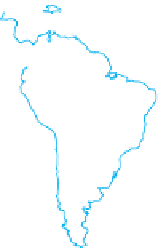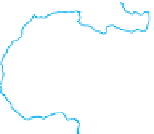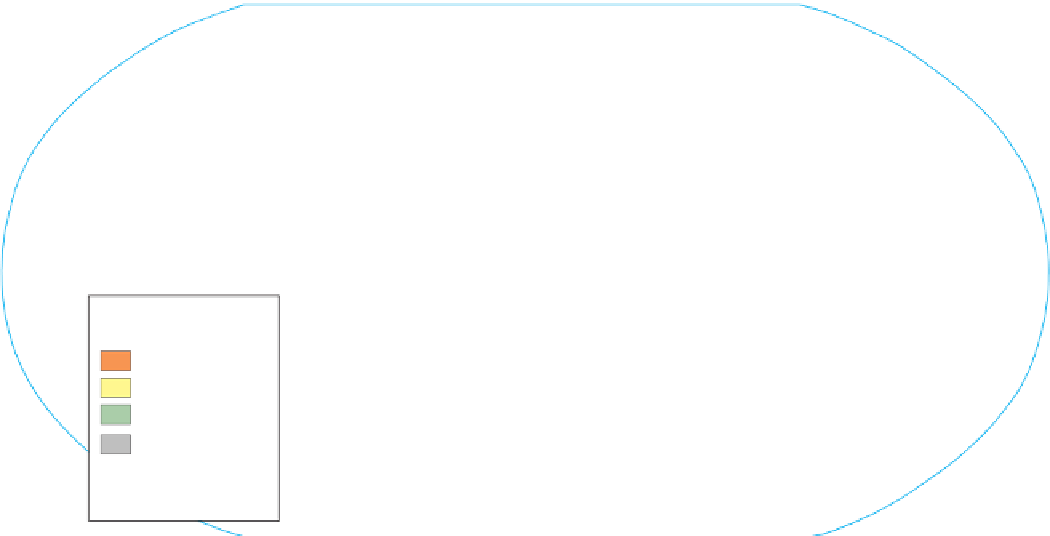Geography Reference
In-Depth Information
Figure 8.10
The World Economy.
One representation of core, periphery, and semi-periphery based on
a calculation called World-Economy Centrality, derived by sociologist Paul Prew. The authors
took into consideration factors not quantifi ed in Prew's data, including membership in the
European Union, in moving some countries from the categories Prew's data recommended to
other categories.
Data from: Paul Prew, World-Economy Centrality and Carbon Dioxide Emissions: A New Look at the
Position in the Capitalist World-System and Environmental Pollution, American Sociological Association, 12, 2 (2010) 162-191.
ARCTIC OCEAN
PACIFIC
OCEAN
ATLANTIC
OCEAN
PACIFIC
OCEAN
INDIAN
OCEAN
THE WORLD-
ECONOMY
Core
Semi-periphery
Periphery
Disputed depending
on criteria used
0
2000 Miles
0
2000 Kilometers
Figure 8.10 presents one way of dividing up the
world in world-systems terms. The map designates some
states as part of the
semiperiphery
—places where core
and periphery processes are both occurring—places that
are exploited by the core but in turn exploit the periphery.
The semiperiphery acts as a buffer between the core and
periphery, preventing the polarization of the world into
two extremes.
Political geographers, economic geographers, and
other academics continue to debate world-systems theory.
The major concerns are that it overemphasizes economic
factors in political development, that it is very state-centric,
and that it does not fully account for how places move
from one category to another. Nonetheless, Wallerstein's
work has encouraged many to see the world political map
as a system of interlinking parts that need to be under-
stood in relation to one another and as a whole. As such,
the impact of world-systems theory has been considerable
in political geography, and it is increasingly commonplace
for geographers to refer to the kinds of core-periphery
distinctions suggested by world-systems theory.
World-systems theory helps explain how colonial
powers were able to amass great concentrations of wealth.
During the fi rst wave of colonialism, colonizers extracted
goods from the Americas and the Caribbean and exploited
Africa for slave labor, amassing wealth through sugar, cof-
fee, fruit, and cotton production. During the second wave
of colonialism, which happened after the Industrial Revo-
lution, colonizers set their sights on cheap industrial labor,
cheap raw materials, and large-scale agricultural plantations.
Not all core countries in the world today were colo-
nial powers, however. Countries including Switzerland,
Singapore, and Australia have signifi cant global clout
even though they were never classic colonial powers, and
that clout is tied in signifi cant part to their positions in the
global economy. The countries gained positions through
access to the networks of production, consumption, and
exchange in the wealthiest parts of the world and through
their ability to take advantage of that access.
World-Systems and Political Power
Are economic power and political power one and the
same? No, but certainly economic power can bring politi-
cal power. In the current system, economic power means
wealth, and political power means the ability to infl uence
others to achieve your goals. Political power is not simply
a function of sovereignty. Each state is theoretically sover-
eign, but not all states have the same
ability
to infl uence
others or achieve their political goals. Having wealth helps
leaders amass political power. For instance, a wealthy




















































































































































































































































































































































































































































































































































































































































































































































































































































































































































































































































































































































































